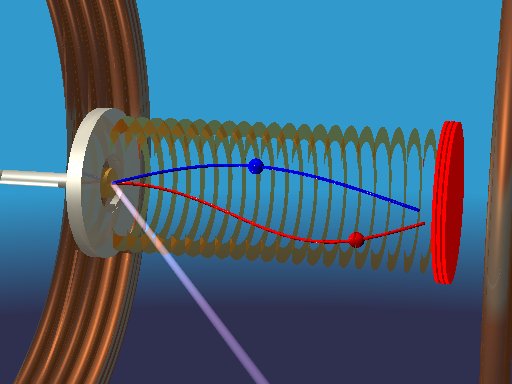|
Object of Research:
The mechanism of how cooper-pairs are created in High-Temperature Superconductors (HTSC) is under heavy debate. Although standard Photoemission experiments (ARPES- angle resolved photoemission spectroscopy) with high energy resolution have revealed a tremendous insight to this materials, it remains an indirect measurement of the underlying correlation.
It has been shown theoretically, that the emission of a cooper-pair by a single photon is possible and the momentum relation is conserved during the photoemission process. Furthermore the measured angular correlations of the emitted electrons can be related to the cooper-pair wave-function.

Experiment:
All experiments are carried out in ultra-high vacuum (10-11 mbar). The sample can be cooled down to 5 K with a liquid helium flow cryostate.
With the multihit positition- and time-sensitive detectors (Roentdek, MCP+Delayline-Anode), we are able to measure in a time-of-flight spectrometer the full momentum of all electrons emitted by a single photon in coincidence. All data is stored in an event-based mode, so that we can distinguish in the offline analysis between events where only one electron is created from those where two electrons are created.
In collaboration with the group of Ralph Claessen (University Würzburg) a preparation chamber with LEED, Argon-gun and sample heating can be attached to the target chamber.

Time of flight spectrometer with magnetic field. Electrons, which are created by a single photon are guided by electric and magnetic fields onto a time- and position-sensitive detector.
Results:
First results on PB(111) show good agreement of the single-electron photoemission with standard ARPES results. Fermi surfaces and the dispersion of the band crossing the Fermi energy is observed.
In the double photoemission data, auger decay is observed at photon energies above 25 eV from the 5d-shells of Pb. So far no changes in the double photoemission spectra are observed when crossing the critical temperature.

First results of Pb(111) surface with 25 eV photons. Left panel: Parallel momentum of a single electron for a fixed kinetic energy around the Fermi energy. Right panel: Double Photoemission energy plot: the sharp cutoff at the sum energy of 16 eV (hv-2*workfuntion) indicates a true 1photon->2electrons process. Intensity along horizontal and vertical line at 3 eV arises from auger decay from the 5d core-level of Pb.
Interesting Papers:
On the theoretical predictions of the emission process of cooper-pairs:
K.A. Kouzakov and J. Berakdar., Phys. Rev. Lett. 91, 257007 (2003)
K.A. Kouzakov and J. Berakdar, J. Elec. Spec. Rel. Phen.161, 121-124 (2007)
First setup of the proposed method and results on electron dynamics in Cu(111)
M. Hattass et. al., Rev. Sci. Instr. 75, 2373 (2004)
M. Hattass et. al., Phys. Rev. B 77, 165432 (2008)
Ph.D.-/Master-/Bachelorthesis
Members:
Stefan Voss
Robert Wallauer
Deborah Schneider
Henning Hohls
Tobias Bauer
Fomer members:
Inka Lauter:
Koinzidenz-Spektroskopie an Hochtemperatursupraleitern: Zwei-Elektronen-Photoemission von Bi2Sr2CaCu2O8+δ
Mirko Hattass:
Koinzidenz-Spektroskopie an Oberflächen: Zwei-Elektronen-Photoemission von Cu(111)
|



